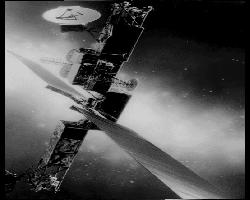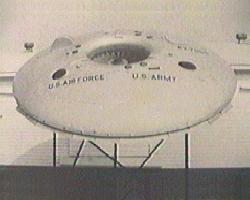Man-made
Identified Flying Objects
About seven in the evening of December 31, 1978,
Mr. Dominic Valdez of Cheshire, England, was standing outside
greeting his sister and brother-in-law, when all three of them
observed a brightly lit cigar shaped UFO apparently some 1,500
feet up, moving across the sky. It was a cold, clear night and
they watched the object, which they reported having lit portholes,
for a minute and a half.
What they had observed was not a UFO, but a man-made
IFO. It was the booster rocket for COSMOS 1068, a Russian satellite.
The Soviets had launched COSMOS earlier, on December 26th, and
the spent booster had taken several days to fall out of orbit
and start burning from friction as it entered the lower atmosphere.
The remains finally crashed near Hanover, Germany.
|

A
satellite in orbit (NASA)
|
Even satellites in normal orbit can be labeled
as UFOs. Appearing as a fast moving, bright point of light in
the early evening hours on clear evenings, a satellite can move
from horizon to horizon in less than five minutes. Occasionally
an older satellite may make a more spectacular, but final, performance
dropping out of orbit and into the atmosphere, burning as it
descends.
A weather balloon also
may appear as a small, bright dot of light in the early evening
or morning. These balloons are released to measure temperature
and gather samples at high altitude. Some, designed to be highly
viable on radar, are used to track wind movement at different
heights. Unlike satellites, weather balloons tend to move slowly,
except during their initial ascent, drifting with the wind .
Balloons may be visible during the daylight hours too.
At lower altitudes aircraft may be mistaken for
UFOs. According to Gerald K. Haines, a historian for the National
Reconnaissance Office, over half the UFO reports from the late
50s though the 60s can be explained away by secret reconnaissance
flights. A favorite maneuver used with the supersonic SR-71
spy planes was to climb to 30,000 feet, hit the afterburners,
do a steep dive to pick up speed for about 15 seconds, then
pull up and climb out at twice the speed of sound. This maneuver,
known as the "dipsy doodle" can appear to an observer who is
standing on the ground ahead of the plane, like a disc dropping
downward, hovering, then racing off and fantastic speeds. This
is a feature commonly reported with UFOs.
Chemicals used to start the SR-71 engines and
afterburners also produced a green "flash" that has sometimes
been noted in UFO reports.
|

A
B-2 Stealth Bomber "flying wing" (USAF)
|
Since a knowledge of the dipsy doodle maneuver
could allow an adversary with quick wits to cover up sensitive
whatever the plane was trying to photograph, the Air Force was
reluctant to connect the UFO stories to SR-71 flights. In fact,
they may have even cultivated it to cover the testing of some
of their secret aircraft developed in the famed Area
51 in Nevada.
Other sources put the idea of SR-71s explaining
some many UFO reports in doubt. Dave Mitchell, a former Avionics
Inertial and Radar Navigation Systems Technician at Beale AFB,
who worked with the SR-71 for 5 years says, "I do not not
accept Mr. Haines' explanations at all. I have the iginition
process on video tape, you cannot see the chemical TEB (tetra-ethyl
borane) flash at 30,000 feet from the ground. An SR-71 flying
at any altitude less than that will leave an unmistakable jet
exhaust sound signature, not any of the silent or humming UFO's
witnesses speak of." Mitchell continues, "If it wasn't
for the unmistakable sound of the exhaust rumble from the engines,
you might mistake it for twin UFO's climbing out when the afterburners
were going then shut off. You'd have to be nearly deaf and the
climb out rate is nowhere as fast as the reported UFOs climb
rate."
A plane seen at an unusual angle can often look
like a disc. The B-2 stealth bomber, with it's unusual "flying
wing" shape and lack of vertical stabilizers, might easily be
misidentified, as could the F-117 stealth fighter. Also the
Army/Air Force did develop a couple of actual disc
shaped aircraft, but these never entered mass production
and are unlikely to have spawned many reports.
|

A
disc-shaped aircraft that was developed, but never got
off the ground. (USAF)
|
Interestingly enough during World War II pilots
from both Allied and Axis forces reported observing "flying
fireballs." Each side supposed this might be a secret weapon
developed by the other. It wasn't till after the war it was
learned that these objects, dubbed "foo fighters"
by the Allied airmen, belonged to neither side. No good explanation
for them has been found.
Bizarre electrical effects
near the ground and around high tension wires may be the source
of some sightings. Many reports of UFOs place them near power
lines or transformer stations. What actually may be seen might
be effects caused by the electricity running through the wire.
Under special environmental conditions the lines may appear
to glow in a similar manner to the natural phenomenon known
as "St. Elmo's Fire."
 Flight
Test a "Flying Wing."
Flight
Test a "Flying Wing."

Copyright Lee
Krystek 1996-2001. All Rights Reserved.